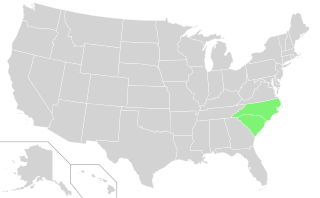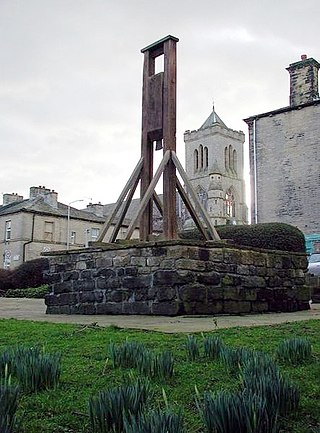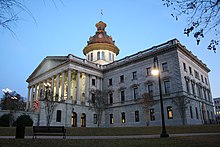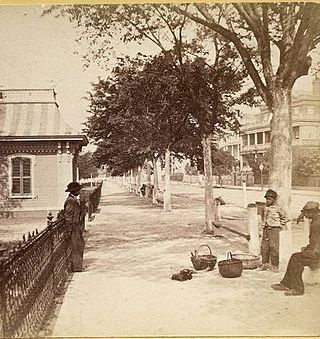
The Carolinas are the U.S. states of North Carolina and South Carolina, considered collectively. They are bordered by Virginia to the north, Tennessee to the west, and Georgia to the southwest. The Atlantic Ocean is to the east.

Province of South Carolina, originally known as Clarendon Province, was a province of the Kingdom of Great Britain that existed in North America from 1712 to 1776. It was one of the five Southern colonies and one of the thirteen American colonies of the British Empire. The monarch of Great Britain was represented by the Governor of South Carolina, until the colonies declared independence on July 4, 1776.

Province of North Carolina was a province of Great Britain that existed in North America from 1712 to 1776.(p. 80) It was one of the five Southern colonies and one of the thirteen American colonies. The monarch of Great Britain was represented by the Governor of North Carolina, until the colonies declared independence on July 4, 1776.

The Province of Carolina was a province of the Kingdom of England (1663–1707) and later the Kingdom of Great Britain (1707–1712) that existed in North America and the Caribbean from 1663 until partitioned into North and South on January 24, 1712. It consisted of all or parts of present-day Alabama, Florida, Georgia, Mississippi, North Carolina, South Carolina, Tennessee, and the Bahamas.

The Granville District was an approximately 60-mile wide strip of land in the North Carolina colony adjoining the boundary with the Province of Virginia, lying between north latitudes 35° 34' and 36° 30'. From 1663 until 1779, the District was held under control of the descendants of Sir George Carteret, one of the original Lords Proprietor of the Province of Carolina. After 1729, the Granville District's land allotment totaled nearly half of the land in North Carolina.

Rawlins Lowndes was an American lawyer, planter and politician who became involved in the patriot cause after election to South Carolina's legislature, although he opposed independence from Great Britain. Lowndes served as president/governor of South Carolina during the American Revolutionary War, and after the war opposed his state's ratification of the U.S. Constitution because it would restrict the trans-Atlantic slave trade. Lowndes also served as a state legislator and mayor of Charleston before his death. Two of his sons, Thomas and William Lowndes, would serve in the U.S. Congress.

John Lorimer Worden was a U.S. Navy officer in the American Civil War, who took part in the Battle of Hampton Roads, the first-ever engagement between ironclad steamships at Hampton Roads, Virginia, on 9 March 1862.
A lord proprietor is a person granted a royal charter for the establishment and government of an English colony in the 17th century. The plural of the term is "lords proprietors" or "lords proprietary".

The history of the colonial period of South Carolina focuses on the English colonization that created one of the original Thirteen Colonies. Major settlement began after 1651 as the northern half of the British colony of Carolina attracted frontiersmen from Pennsylvania and Virginia, while the southern parts were populated by wealthy English people who set up large plantations dependent on slave labor, for the cultivation of tobacco, cotton, rice, and indigo.

The Fundamental Constitutions of Carolina were adopted on March 1, 1669 by the eight Lords Proprietors of the Province of Carolina, which included most of the land between what is now Virginia and Florida. It replaced the Charter of Carolina and the Concessions and Agreements of the Lords Proprietors of the Province of Carolina (1665). The date March 1, 1669 was the date that proprietors confirmed the Constitutions and sent them to the Colony, but later on two other versions were introduced in 1682 and in 1698. Moreover, the proprietors suspended the Constitutions in 1690. Despite the claims of proprietors on the valid version of the Constitution, the colonists officially recognized the July 21, 1669 version, claiming that six proprietors had sealed the Constitutions as "the unalterable form and rule of Government forever" on that date. The earliest draft of this version in manuscript is believed to be the one found at Columbia, South Carolina archives.
Cary's Rebellion was an uprising against the Deputy Governor of North-Carolina in 1711 led by Thomas Cary, who refused to give up his governorship to Edward Hyde. The rebellion was a part of a long-standing tension between religious and political groups in northern Carolina, generally divided between the Quaker party, of which Cary was a part, and the Church of England party, to which Hyde belonged.


Robert King "Bob" Wittman is a highly decorated former Federal Bureau of Investigation special agent who was assigned to the Philadelphia Field Division from 1988 to 2008. Having trained in art, antiques, jewelry and gem identification, Wittman served as the FBI's "top investigator and coordinator in cases involving art theft and art fraud". During his 20 years with the FBI, Wittman helped recover more than $300 million worth of stolen art and cultural property, resulting in the prosecution and conviction of numerous individuals. In 2005, he was instrumental in the creation of the FBI's rapid deployment Art Crime Team (ACT). He was named the ACT's senior investigator and was responsible for instructing the newly formed team. He also was instrumental in the recovery of colonial North Carolina's copy of the original Bill of Rights in 2005, that had been stolen by a Union soldier in 1865. Wittman represented the United States around the world, conducting investigations and instructing international police and museums in recovery and security techniques. After 20 years with the FBI working against art theft, he worked as an art security consultant for the private sector. In 2010, Wittman published his memoir Priceless which recounts his career and activities while working for the FBI as an undercover agent.
The following are minor or locally celebrated holidays related to the American Revolution.

The Grand Model was a utopian plan for the Province of Carolina, founded in 1670. It consisted of a constitution coupled with a settlement and development plan for the colony. The former was titled the Fundamental Constitutions of Carolina. The word "constitutions" was synonymous with "articles." The document was composed of 120 constitutions, or articles. The settlement and development plan for the colony consisted of several documents, or "instructions," for guiding town and regional planning as well as economic development.
The Revolution of 1719 was a bloodless military coup in the Province of South Carolina which resulted in the overthrow of the Lords Proprietors and the installation of Colonel James Moore, Jr. as the colony's de facto ruler. The Revolution of 1719 led to the permanent end of proprietary rule in South Carolina and its recreation as a crown colony.













